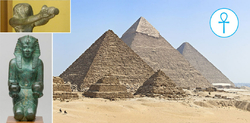- Retour accueil
- Vous êtes ici : Blog The Pyramids of the Cold The Pyramids of the Cold Section 9 • The Was Scepter, Sa Symbol and Isis Knot
The Pyramids of the Cold Section 9 • The Was Scepter, Sa Symbol and Isis Knot
Publié par Bruno Coursol dans The Pyramids of the Cold le 12/04/2022 à 20:10
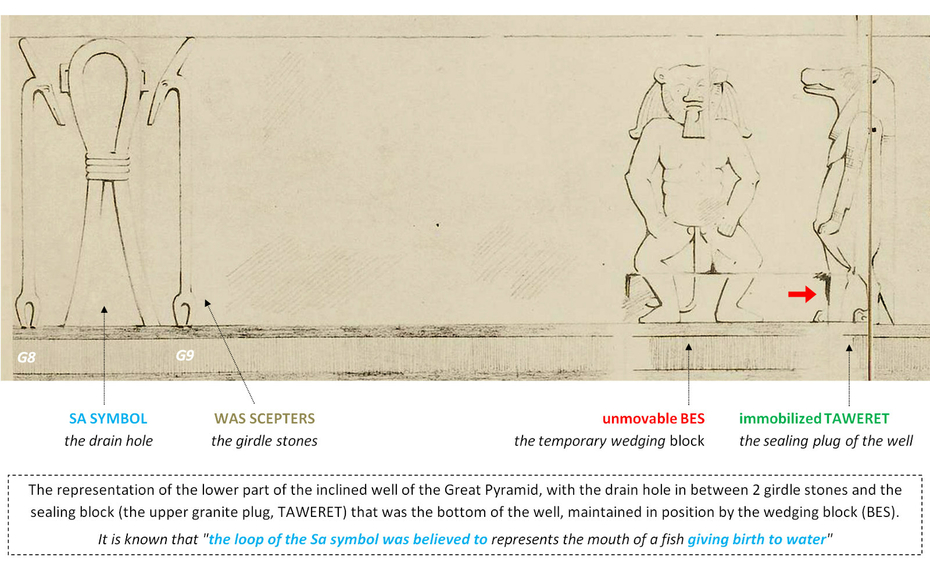
Hatshepsut’s birth scene, from Édouard Naville "The Temple of Deir el Bahari" (London, 1896), vol. 2, pl. 50. Image courtesy of the University Library Heidelberg : The Ebony shrine, northern half of the middle platform. https://digi.ub.uni-heidelberg.de/diglit/naville1896bd2/0050
The Pyramids of the Cold - Section 9 • The Was Scepter, the Sa Symbol and the Tyet Isis Knot
In summary : the Sa symbol is a representation of the opened drain hole of the Great Pyramid inclined well, while the Tyet knot of Isis represents the drain hole locked and closed. Was scepters are representations of the girdle stones of the inclined well of the Great Pyramid of Giza, they represent dominion and power over snakes… and water (snakes = water).
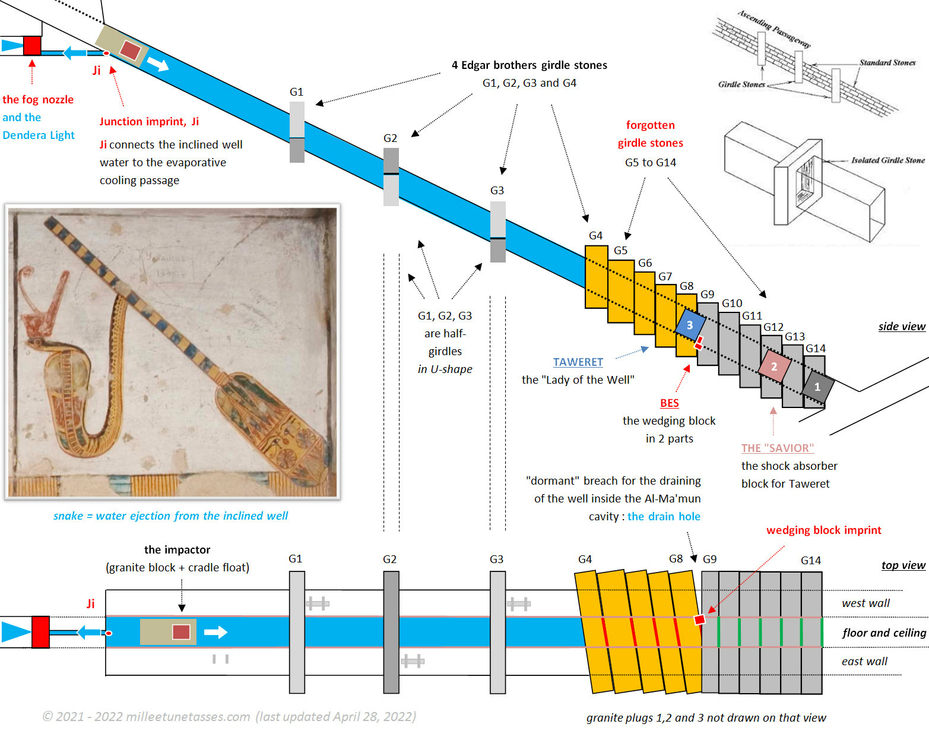
The girdle stones layout of the inclined well of the Great Pyramid of Giza. Photograph from tomb KV 11 of Ramesses III, side chamber, image # 21076 by Matjaz Kacicnik, courtesy of ARCE, American Research Center in Egypt in partnership with the American University in Cairo Egyptology Department : https://thebanmappingproject.com/images/21076jpg
During the entire operating period of the pyramid, the bottom of the inclined well was sealed by the Taweret blog : the upper granite plug. Taweret was maintained in position by a wedging block presenting an easy to break protruding part, getting out of the floor of the well. The breaking of that fragile part released the Taweret block and the waters of the well were drained through the dormant breach, between the Girdle Stones G8 and G9.
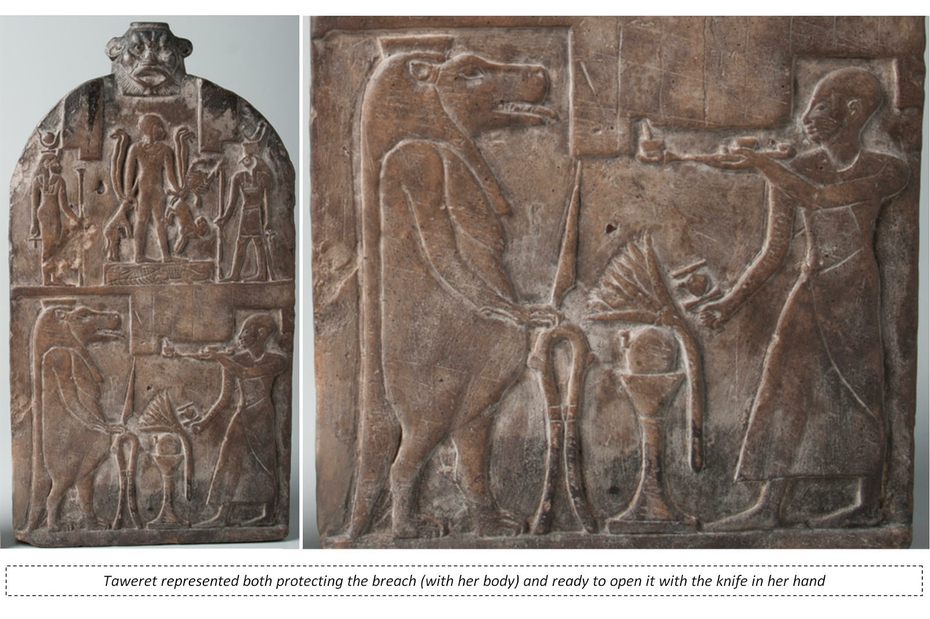
Magical stele (detail), Egyptian, Late Period, 26th–31st dynasty, c. 664–332 BCE. Limestone. Harvard Art Museums/Arthur M. Sackler Museum, Bequest of Gerhardt Liebmann, 1991.642 : https://harvardartmuseums.org/article/a-salve-for-your-snake-bites
9.01 Taweret is protecting the drain hole but she is also ready to open it
Taweret is often represented with the Sa symbol pressed onto her belly, like on the above image of a magical stele : it shows that Taweret is protecting the Sa symbol. But here, she also has a knife in her hand : she is also the one who can destroy it.
Taweret is both protecting and ready to destroy the Sa symbol.

9.02 The Sa symbol is the drain hole of the well : "the loop of the Sa symbol was believed to give birth to water"
The fact that Bes and Taweret are the only deities associated with the Sa symbol could only mean that this symbol is a representation of the breach itself.
On the above first images of Taweret, we can see that the Sa symbol is hiding a "pouring hole" that is strongly suggesting the draining of the water. On the last image of Taweret, she is depicted giving birth to a snake, meaning : to water.
Also, it is known that "the loop of the Sa symbol was believed to represents the mouth of a fish giving birth to water". Source : https://www.landofpyramids.org/sa-symbol.htm
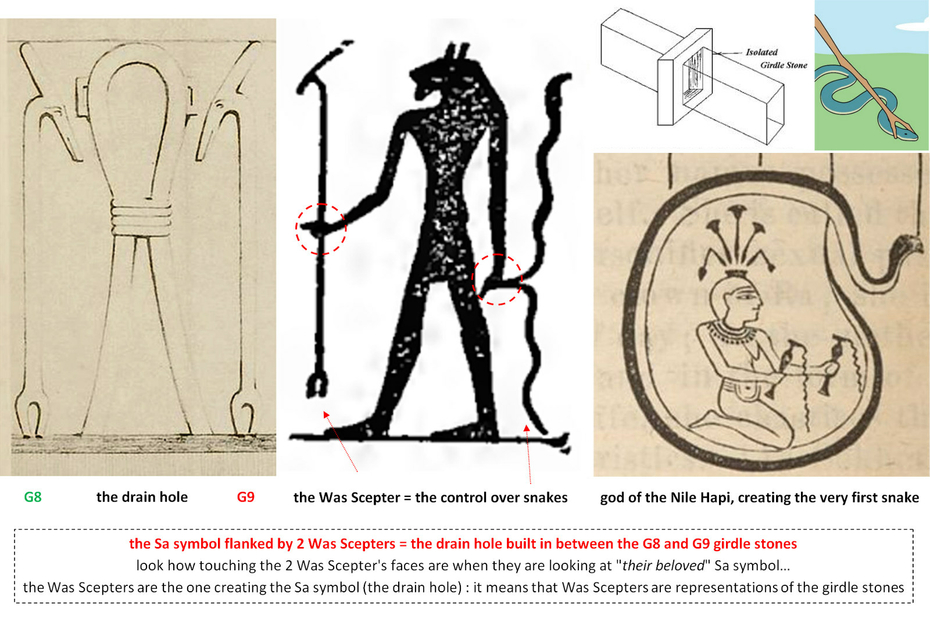
Was Scepters are the representation of the girdle stones of the Great Pyramid of Giza inclined well.
Draw of a relief on the North wall of the Gate of Hadrian with a representation of the Nile god Hapi, crouched in his cave and surrounded by a serpent, Isis temple at Philae, Egypt : https://fr.wikipedia.org/wiki/Fichier:Hapy_Philae.JPG
How to Catch a Snake : https://www.wikihow.com/Catch-a-Snake
9.03 Dominion over water : the Was Scepters are representations of the Girdle Stones
The Hatshepsut’s birth scene relief turns out to be a real gold mine, because not only we can validate the Bes and Taweret interpretation, as well as the understanding of the Sa symbol, but we can also decipher another symbol from this relief : the Was Scepter.
On the left side of the Bes and Taweret scene, we can see the Sa symbol flanked by 2 Was Scepters. These scepters are not randomly positioned : they are both turning their faces towards the Sa symbol. They are flanking the Sa symbol and looking right to it like it was their baby. Don't you think the Was Scepters have a very touching/loving/amusing kind of look, facing the Sa symbol ?
Well, I do, and I also think that somehow, the Sa symbol really is their little baby !
We've just seen that the Sa symbol was a representation of the drain hole of the well, and we also know that this drain hole was set in between 2 particular girdle stones : G8 and G9 (more information on that matter, on previous posts).
What it means is that the Was Scepters are representations of the girdle stones.
And it makes perfect sense. We know that snakes were representations of the water used to power up the Great Pyramid, so what better way of representing the control over that water, than by the control over snakes.
If Was Scepters are very much looking exactly like snake handling tongs, it is because they really are snake tongs. Except of course these snake tongs are actually metaphors.
Ancient Egyptians didn't want to talk about the control they had over snakes, but over the "magical" pressurized water of the well : they wanted to talk about the containment of the waters of the well.
This idea of having power over snakes that would be associated with the Was Scepter, is exactly what is saying the second above image. Both hands are doing the same thing : the firm grip on snakes (control over snakes) on one hand is equal to the Was Scepter hold in the other hand.
Also, from Wikipedia's page on the Was Scepter : "Was sceptres were used as symbols of power or dominion, and were associated with ancient Egyptian deities such as Set or Anubis as well as with the pharaoh. Was sceptres also represent the Set animal. In later use, it was a symbol of control over the force of chaos that Set represented."
This "force of chaos" is the pressurized water of the well.

Was Scepter from Djoser's Step Pyramid, constraining water and redirecting some of it.
Was Scepter from Djoser's Step Pyramid, now at the Imhotep Museum, part of a doorway with blue faïence tiles from beneath the Step Pyramid, thanks to kairoinfo4U : https://www.flickr.com/photos/manna4u/5260508828/
9.04 The containment of the pressurized waters of the well and the sequential ejection
The idea that Was Scepters are representations of the girdle stones of the Great Pyramid and metaphors of the containment of the waters of the inclined well, is exactly what is suggested by the above images from Djoser's Step Pyramid where a Was Scepter is "holding tight" something in his hands. That something, with no particular shape, is water.
Djoser's Was Scepter is constraining that water with one arm, and at the same time he is redirecting some of it with the other arm. The weird "scorpion" shape element with its 2 cuffed arms is representing the small amount of pressurized water getting out of the well towards the horizontal cooling passage.
Also, we've already seen that the Step Pyramid was involved in a cooling process : "Of course, Imhotep is most famous as the builder of Djoser's unprecedented step pyramid complex, called the "The Refreshment of the Gods.” Source : https://www.arce.org/resource/search-imhotep-tomb-architect-turned-god-remains-mystery
Again, the idea that the Was Scepter is a metaphor for some liquid in motion is already known :
"De Lubicz via Paul LaViolette speaks of the was as "a living branch that conducts nourishing, vivifying sap, fluid that ascends..." and even found some was scepters "made from the living branch of a tree that had been cut so as to include a section of the lower source branch as well as two offshoots coming from its upper end". (Genesis of the Cosmos, page 30)". Source : http://www.joanlansberry.com/setfind/earlywas.html
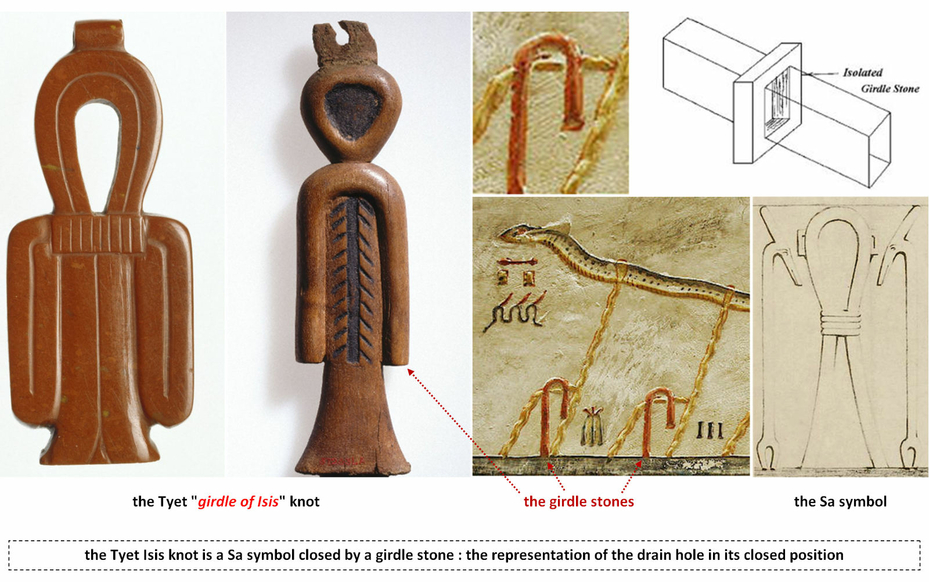
The Tyet Isis knot is a representation of the drain hole of the Great Pyramid inclined well, in its closed position.
Isis-knot Amulet https://www.brooklynmuseum.org/opencollection/objects/4131 and Tyt-Amulet from the Brooklyn Museum : https://www.brooklynmuseum.org/opencollection/objects/3994
9.05 The Tyet "girdle of Isis" knot is the drain hole in its closed and locked position
The interpretation of the Sa symbol being the drain hole is actually incomplete : because it is known that the loop was "giving birth to water", it would be more appropriate to consider the Sa symbol as the drain hole in its opened position, as are suggesting its opened legs.
It would mean that ancient Egyptians had most probably also represented the drain hole in its closed position, when the girdle stones would have completely sealed the hole.
And that is precisely what they did : the Tyet Isis knot is the drain hole in a closed position.
The above Tyet amulet from the Brooklyn Museum, is even showing the girdle stone representation itself : that is the inverted U shaped element that we've already seen in the relief of Apep being restrained by these same girdles.
We don't have to be fooled by the fact that on the Apep relief, the legs of the girdles aren't the same length : this is only the result of the perspective that used the artist to represent kind of a 3D effect.
Also : "The tyet (Ancient Egyptian: tjt), sometimes called the knot of Isis or girdle of Isis, is an ancient Egyptian symbol that came to be connected with the goddess Isis." https://en.wikipedia.org/wiki/Tyet
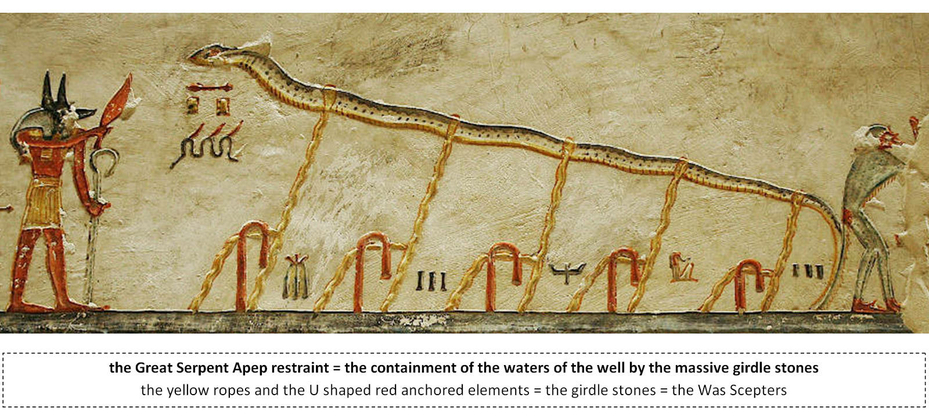
The restraining of Apep is a representation of the containment of the pressurized waters of the Great Pyramid inclined well.
The restraining of Apep in the above relief from Ramesses KV19 tomb, is another representation of the containment of the inclined well pressurized waters. Once pressurized and contained into the well, a small amount of the "powered" waters can be redirected towards the evaporative cooling passage.
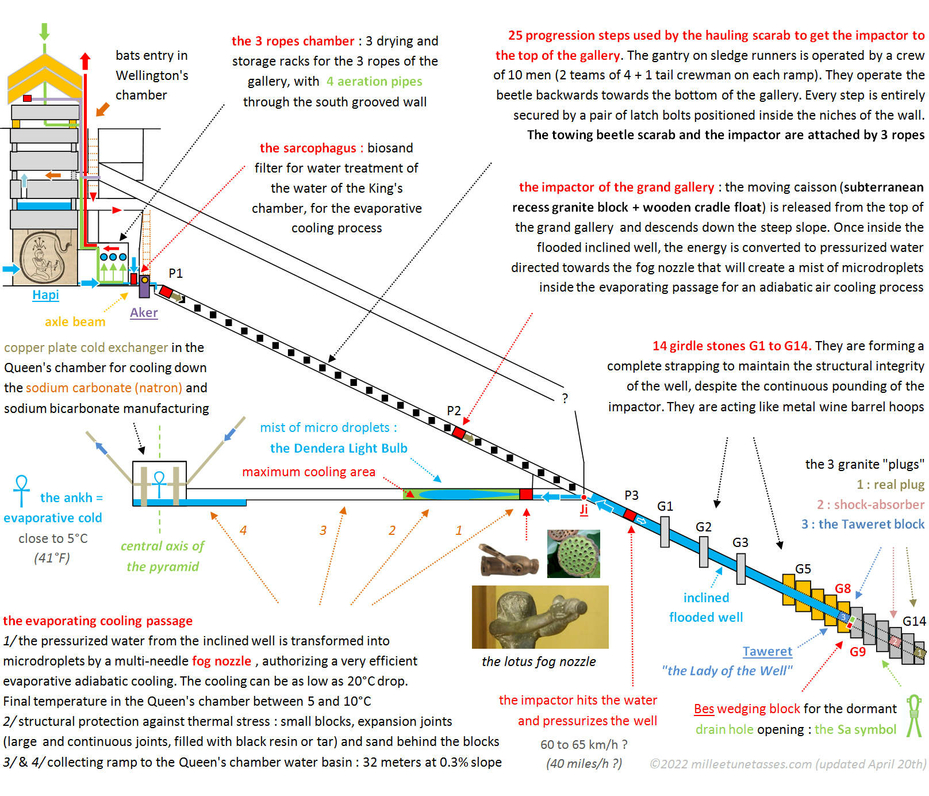
Diagram of the Great Pyramid of Egypt in operation, before the shutdown procedure and the draining of the inclined well.
9.06 Summary of the study : hidden behind the academic vision of the ancient Egyptian religion, a vast number of metaphors are describing some of the most advanced science and technological knowledge of that time : ancient Egyptian gods were nothing else than pharaohs' metaphoric self-glorifications of their theoretical and experimental scientific accomplishments in physics and chemistry.
Pharaohs used the power of Science to legitimate themselves as kings of Egypt : they forged an entire religion, based on science to rule their kingdom, and they presented that science as Magic.
The end game of this technological program that probably started on the very first Dynasty, was the Great Pyramid of Giza where evaporative cooling was engineered in the known part of the pyramid from the pressurized water produced in the inclined well, known today as the ascending passage.
The evaporative cold simply took advantage of the power of water, and was most probably necessary to cool down chemical manufacturing of sodium carbonate and sodium bicarbonate produced by an ammonia-soda Solvay process, as suggested by the very strong ammonia smell and the limestone kiln in the so-called burial chamber of the Red Pyramid. At that time, sodium carbonate was called natron, and it was the salt used for the mummification of the pharaohs (Sections 14, 15 and 16).
The cooling seems to have represented the most difficult part of the process, as suggested by the Step Pyramid's official name : according to scholars, the very first pyramid complex, the Step Pyramid of Djoser, was called "the refreshment of the Gods". No doubt that a more accurate translation would certainly be "the cooling of the Gods".
It means that ancient Egyptians were the first civilization to master a Solvay-like process for sodium carbonate manufacturing, long before it got reinvented in the 1800's in Europe. The key elements of that process is the temperature control of the chemical reactions (the cooling), and the dome shaped plate necessary for the counterflow chemical reactions to occur in an efficient way. That counterflow reaction plate is what really is the disc of Sabu.
As shown with Akhenaten and Nefertiti, the creation of the evaporative cold was the most sacred accomplishment of all (Section 17), and this is exactly what the Dendera Light is all about : the Dendera Light is the fog of microdroplets of liquid water that evaporates and creates the cold. Talking about the snake inside the Dendera Light Bulb : "The field surrounding Ra’s snake form is referred to in ancient Egyptian literature as protective magical energy in liquid form that all gods and pharaohs possess" (Faulkner, Section 2).
Everything that had been done in the Great Pyramid of Giza inspired most of the ancient Egyptian religion, and it had been glorified into what we know today as the Underworld.
The Underworld is referring to the chambers and passages of the Great Pyramid of Khufu, and in particular to the Grand Gallery where a hauling gantry beetle operated a wooden coffin shaped impactor that had a small nested granite block inside it. The impactor generated endlessly, over and over, maybe every 15 minutes the pressurized water that was then transformed into a fog of microdroplets inside the horizontal cooling passage.
The Grand Gallery of the Great Pyramid where the act of hauling was done, is the "Secret Hauling Cavern of the Underworld" described in the Amduat "Book of the Hidden Chamber".
The most important chamber of the Great Pyramid wasn't the King's chamber that only was the main water tank of the pyramid, but the Queen's chamber, the only one on the central axis of the pyramid. Because the Queen's chamber was inaccessible from the rest of the pyramid, it was glorified into the "Hidden Chamber of the Underworld" (Section 11), and because the Queen's chamber was the coolest place in the pyramid (about 5°C / 41°F), and with a constant 100% Humidity rate, this chamber was the one where the biggest amount of very hard salt encrustation had been documented by the first explorers of the pyramid in the 1800's and before it had been removed in 1998 by Zahi Hawass (Section 1). Very hard salt encrustation is the signature of the evaporative cooling process, even nowadays.
The most incredible thing is that pretty much everything I've just said, actually appears in one single myth, but it doesn't originate from ancient Egypt : it is the "Churning of the Ocean" Hindu myth that produces the immortal nectar Amrita. The fact is that the endless churning of water that ends up with the production of an elixir that gives eternal life, is exactly what were doing ancient Egyptians in the inclined well : natron was the salt used for the mummification of pharaohs.
Natron gave eternal life to pharaohs, just like the Amrita (Section 19).

© 2022 Copyright milleetunetasses.com. All rights reserved.
Poster un commentaire
